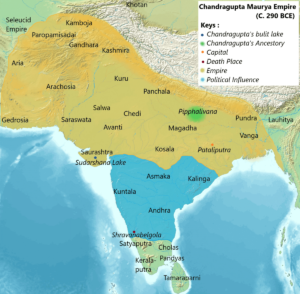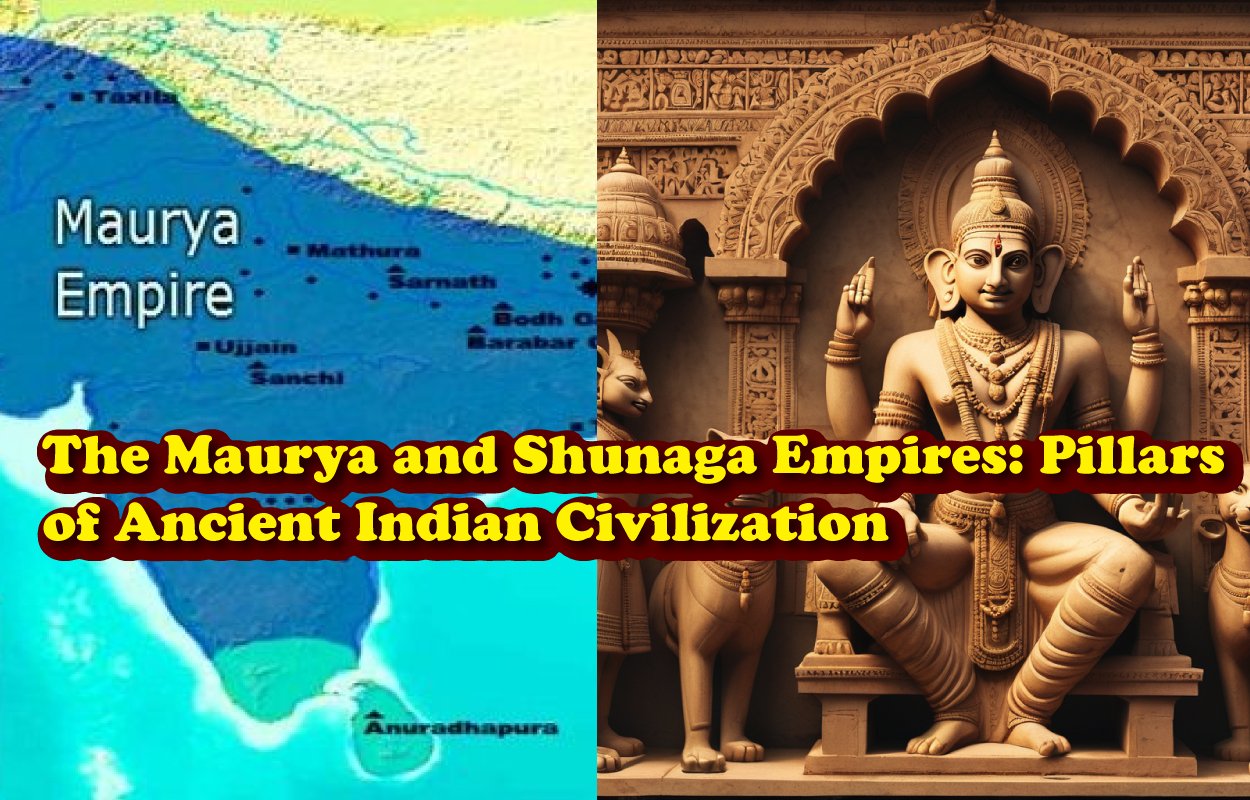The Maurya and Shunaga empires were two of the most influential and transformative political entities in ancient India. Their impact on Indian history extends beyond their political achievements to include cultural, economic, and social developments. This article explores the origins, achievements, and legacies of these two empires, highlighting their significance in shaping the Indian subcontinent.
The Maurya and Shunaga Empires
1. The Maurya Empire: An Overview
1.1. Origins and Founding
The Maurya Empire was founded by Chandragupta Maurya in 322 BCE, marking the beginning of one of the most significant empires in Indian history. Chandragupta, a member of the Kshatriya class, established the Maurya dynasty after overthrowing the Nanda dynasty, which had ruled the Magadh region. His rise to power was aided by his advisor, Chanakya (also known as Kautilya), a renowned scholar and strategist.
1.2. Key Rulers and Achievements
– Chandragupta Maurya (reigned 322–297 BCE): Chandragupta laid the foundation of the Maurya Empire, uniting much of the Indian subcontinent under his rule. His administration was notable for its efficiency and organization, as described in Chanakya’s treatise, the *Arthashastra*.
– Bindusara (reigned 297–273 BCE): The son of Chandragupta, Bindusara expanded the empire further and consolidated its power. His reign saw the stabilization of the empire and the continuation of its expansionist policies.
– Ashoka the Great (reigned 268–232 BCE): Ashoka is perhaps the most famous Mauryan ruler, known for his conversion to Buddhism and his promotion of non-violence and dharma (moral law). His reign marked a significant period of peace and prosperity. Ashoka’s edicts, inscribed on pillars and rocks throughout his empire, provide valuable insights into his governance and the spread of Buddhism.
1.3. Administration and Governance
The Maurya Empire was characterized by a centralized and bureaucratic system of governance. The empire was divided into provinces, each administered by a governor appointed by the emperor. The central administration, headquartered in Pataliputra (modern Patna), was responsible for maintaining order, collecting taxes, and implementing policies.
The empire’s legal and administrative systems were sophisticated, with a well-defined system of justice and a network of spies and informants to maintain internal security. The *Arthashastra* by Chanakya outlines the principles of statecraft, including diplomacy, espionage, and economic management.
1.4. Cultural and Economic Contributions
Under the Maurya Empire, India experienced significant cultural and economic advancements. The promotion of Buddhism by Ashoka led to the establishment of numerous stupas, monasteries, and universities, contributing to the spread of Buddhist philosophy and culture.
Economically, the Mauryan period saw the development of trade routes, both within India and with foreign lands. The empire’s extensive network facilitated the exchange of goods, ideas, and cultural practices, leading to a period of prosperity and cultural exchange.
1.5. Decline and Legacy
The decline of the Maurya Empire began after Ashoka’s death, with successive rulers failing to maintain the empire’s cohesion. By the early 2nd century BCE, the empire had fragmented into smaller states. Despite its decline, the Maurya Empire’s legacy endured through its contributions to Indian administration, culture, and religion.

2. The Shunaga Empire: An Overview
2.1. Origins and Establishment
The Shunaga Empire, also known as the Shunga Empire, emerged after the decline of the Maurya Empire. It was established by Pushyamitra Shunga, a general of the Maurya Empire who seized power in 185 BCE, marking the beginning of the Shunga dynasty. Pushyamitra’s rise to power was a reaction against the perceived decline in Mauryan authority and corruption within the empire.
2.2. Notable Rulers and Achievements
– Pushyamitra Shunga (reigned 185–149 BCE): The founder of the Shunga Empire, Pushyamitra Shunga is known for his efforts to restore Brahmanical traditions and oppose Buddhism. His reign was marked by military campaigns to consolidate and expand his territory.
– Vasudeva Shunga (reigned 149–142 BCE): Pushyamitra’s successor, Vasudeva, continued the expansion and consolidation of the empire. His reign was marked by political stability and cultural patronage.
– Bhagabhadra (reigned 142–133 BCE): Bhagabhadra’s rule saw a period of relative peace and prosperity, with continued patronage of arts and culture.
2.3. Administrative Structure and Governance
The Shunga Empire retained many administrative practices from the Maurya period, but with a stronger emphasis on Brahmanical values. The administration was centralized, with the emperor exercising significant control over the empire’s various regions. The Shungas are noted for their efforts to promote Hinduism and support Brahmanical scholars and institutions.

2.4. Cultural and Social Developments
The Shunga period is notable for its contributions to Indian art and culture. The empire saw the continuation of architectural and artistic developments, including the construction of stupas and viharas. The famous Sanchi Stupa, a significant Buddhist monument, was enlarged and embellished during the Shunga period.
In addition to its architectural achievements, the Shunga Empire played a role in the revival of Hinduism and the Brahmanical traditions that had been overshadowed during the Mauryan period. The Shungas promoted the study of Hindu scriptures and supported the Brahminical priesthood.
2.5. Decline and Historical Impact
The Shunga Empire gradually declined due to internal strife and external pressures. By the late 2nd century BCE, the empire had weakened, leading to its eventual replacement by the Kanva dynasty in 75 BCE. Despite its decline, the Shunga Empire’s contributions to art, culture, and religion had a lasting impact on Indian civilization.

3. Comparative Analysis: Maurya vs. Shunaga Empires
The Maurya and Shunaga empires were two distinct but interconnected phases in Indian history. The Maurya Empire was characterized by its expansive territorial control, administrative innovations, and promotion of Buddhism under Ashoka. In contrast, the Shunga Empire focused on consolidating power in the wake of the Mauryan decline, with a renewed emphasis on Brahmanical traditions and cultural revival.
While the Mauryan Empire’s influence was marked by its unification of a large part of the Indian subcontinent and its promotion of Buddhism, the Shunga Empire is remembered for its efforts to restore and reinforce Hinduism and its contributions to art and architecture.
The Maurya and Shunaga empires were pivotal in shaping the course of ancient Indian history. The Maurya Empire, with its centralized administration and promotion of Buddhism, set the stage for significant cultural and political developments. The Shunga Empire, emerging from the Mauryan decline, played a crucial role in the revival of Brahmanical traditions and the continuation of artistic and cultural achievements.
Together, these empires represent a dynamic period in Indian history, characterized by political change, cultural evolution, and the interplay of religious and philosophical ideas. Their legacies continue to influence Indian culture and history, providing valuable insights into the complexities of ancient Indian civilization.
See more:
